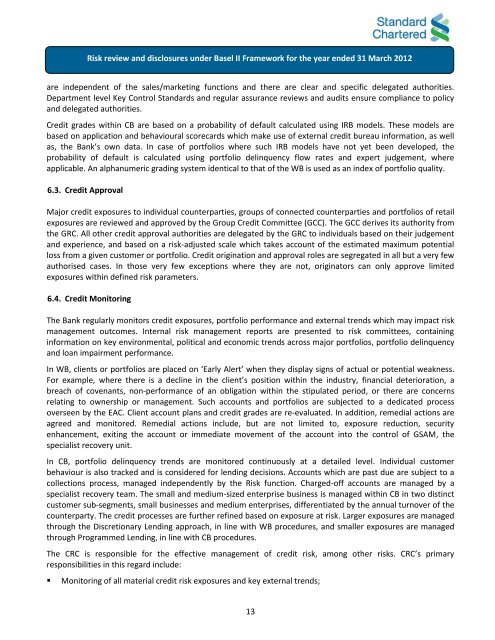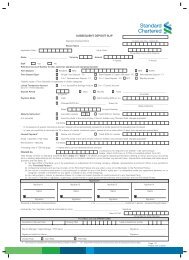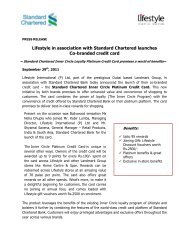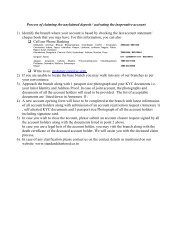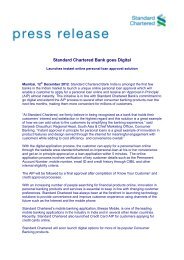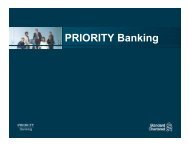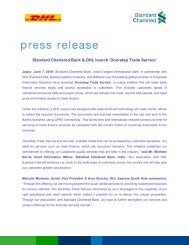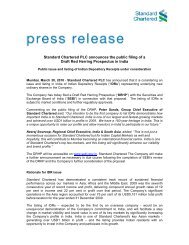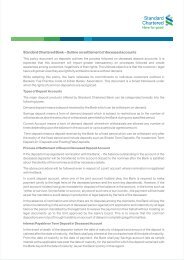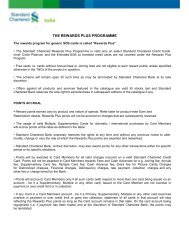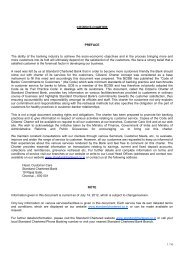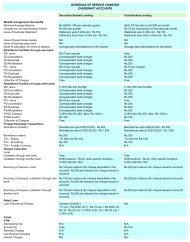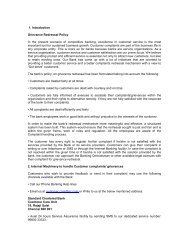March 12 - Standard Chartered Bank
March 12 - Standard Chartered Bank
March 12 - Standard Chartered Bank
You also want an ePaper? Increase the reach of your titles
YUMPU automatically turns print PDFs into web optimized ePapers that Google loves.
Risk review and disclosures under Basel II Framework for the year ended 31 <strong>March</strong> 20<strong>12</strong><br />
are independent of the sales/marketing functions and there are clear and specific delegated authorities.<br />
Department level Key Control <strong>Standard</strong>s and regular assurance reviews and audits ensure compliance to policy<br />
and delegated authorities.<br />
Credit grades within CB are based on a probability of default calculated using IRB models. These models are<br />
based on application and behavioural scorecards which make use of external credit bureau information, as well<br />
as, the <strong>Bank</strong>’s own data. In case of portfolios where such IRB models have not yet been developed, the<br />
probability of default is calculated using portfolio delinquency flow rates and expert judgement, where<br />
applicable. An alphanumeric grading system identical to that of the WB is used as an index of portfolio quality.<br />
6.3. Credit Approval<br />
Major credit exposures to individual counterparties, groups of connected counterparties and portfolios of retail<br />
exposures are reviewed and approved by the Group Credit Committee (GCC). The GCC derives its authority from<br />
the GRC. All other credit approval authorities are delegated by the GRC to individuals based on their judgement<br />
and experience, and based on a risk-adjusted scale which takes account of the estimated maximum potential<br />
loss from a given customer or portfolio. Credit origination and approval roles are segregated in all but a very few<br />
authorised cases. In those very few exceptions where they are not, originators can only approve limited<br />
exposures within defined risk parameters.<br />
6.4. Credit Monitoring<br />
The <strong>Bank</strong> regularly monitors credit exposures, portfolio performance and external trends which may impact risk<br />
management outcomes. Internal risk management reports are presented to risk committees, containing<br />
information on key environmental, political and economic trends across major portfolios, portfolio delinquency<br />
and loan impairment performance.<br />
In WB, clients or portfolios are placed on ‘Early Alert’ when they display signs of actual or potential weakness.<br />
For example, where there is a decline in the client’s position within the industry, financial deterioration, a<br />
breach of covenants, non-performance of an obligation within the stipulated period, or there are concerns<br />
relating to ownership or management. Such accounts and portfolios are subjected to a dedicated process<br />
overseen by the EAC. Client account plans and credit grades are re-evaluated. In addition, remedial actions are<br />
agreed and monitored. Remedial actions include, but are not limited to, exposure reduction, security<br />
enhancement, exiting the account or immediate movement of the account into the control of GSAM, the<br />
specialist recovery unit.<br />
In CB, portfolio delinquency trends are monitored continuously at a detailed level. Individual customer<br />
behaviour is also tracked and is considered for lending decisions. Accounts which are past due are subject to a<br />
collections process, managed independently by the Risk function. Charged-off accounts are managed by a<br />
specialist recovery team. The small and medium-sized enterprise business is managed within CB in two distinct<br />
customer sub-segments, small businesses and medium enterprises, differentiated by the annual turnover of the<br />
counterparty. The credit processes are further refined based on exposure at risk. Larger exposures are managed<br />
through the Discretionary Lending approach, in line with WB procedures, and smaller exposures are managed<br />
through Programmed Lending, in line with CB procedures.<br />
The CRC is responsible for the effective management of credit risk, among other risks. CRC’s primary<br />
responsibilities in this regard include:<br />
• Monitoring of all material credit risk exposures and key external trends;<br />
13


